Particle emissions from ships at berth using heavy fuel oil
In this study, the composition of exhaust from a marine diesel auxiliary engine running on
Heavy Fuel Oil (HFO) on-board a large cargo vessel was investigated. Measurements of particle
number and size distributions in the range 5-1000 nm and gaseous emissions of O2, CO, CO2, SO2 and
NOx were undertaken. The measurements were performed on two large cargo ships at berth and during
travel. Measurements were also carried out on auxiliary engines of two ships when they were at berth.
Data on engine power, engine revolution, fuel oil consumption, intercooled air temperature, scavenging
air pressure, cooling fresh water and exhaust gas temperature were measured using instrumentation of
the ship. Results showed that emission factors (g/kWh) are higher than that of previous studies for SO2.
This may be due to the high sulphur content of fuel. Particle number size distribution was observed to
be the highest around 35 – 45 nm in diameter, and the particle number remarkably decreased during
higher engine load conditions
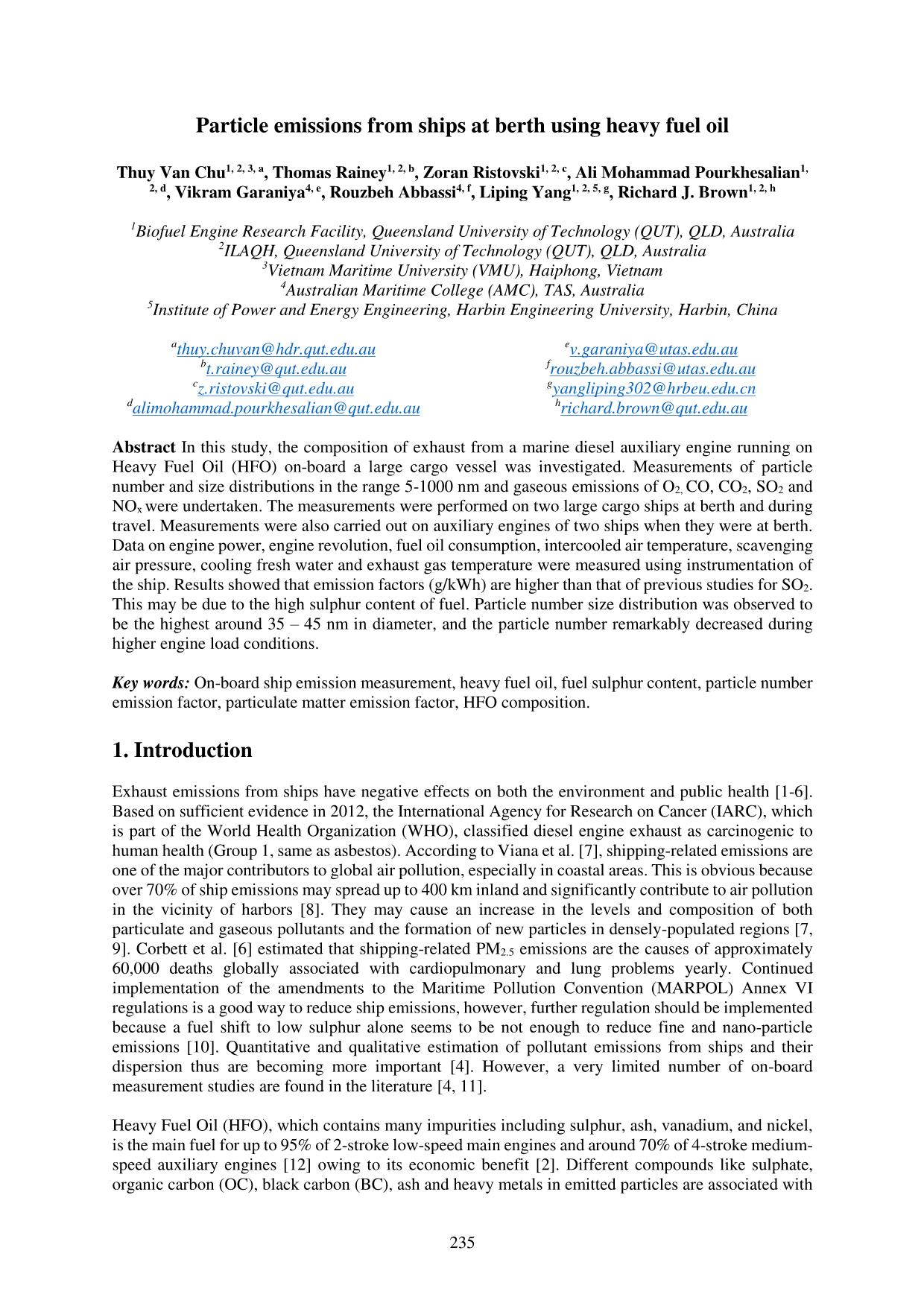
Trang 1
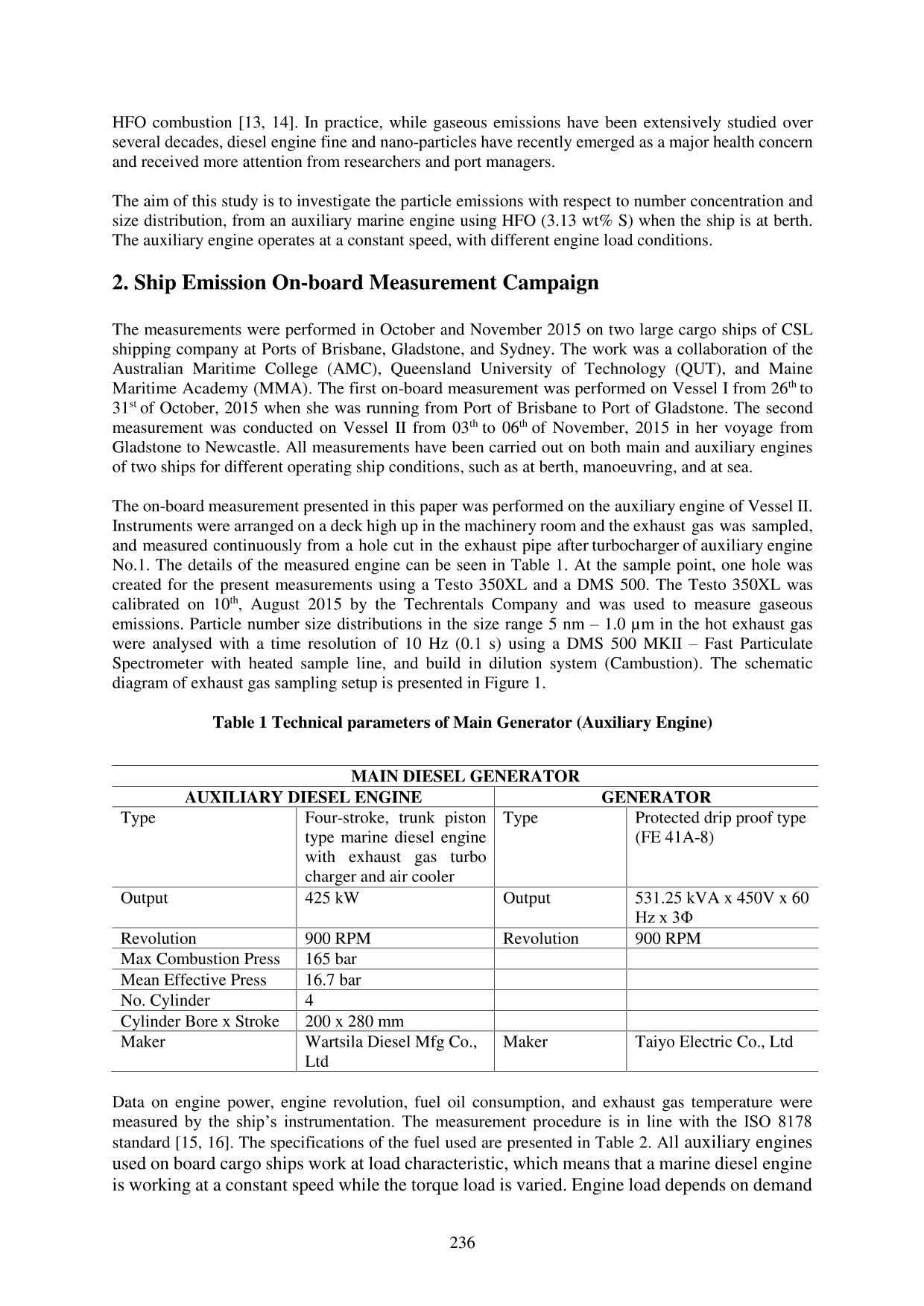
Trang 2
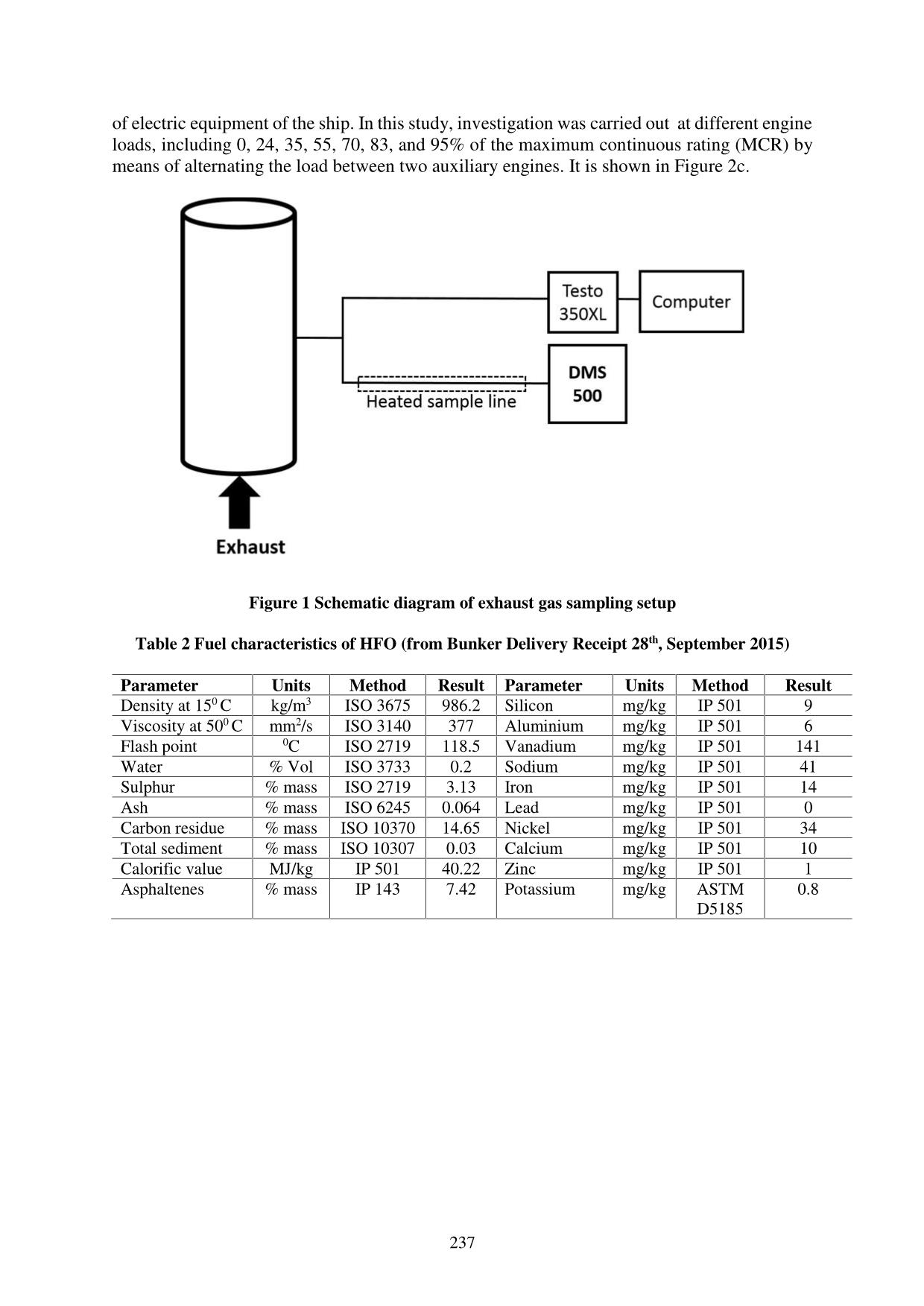
Trang 3
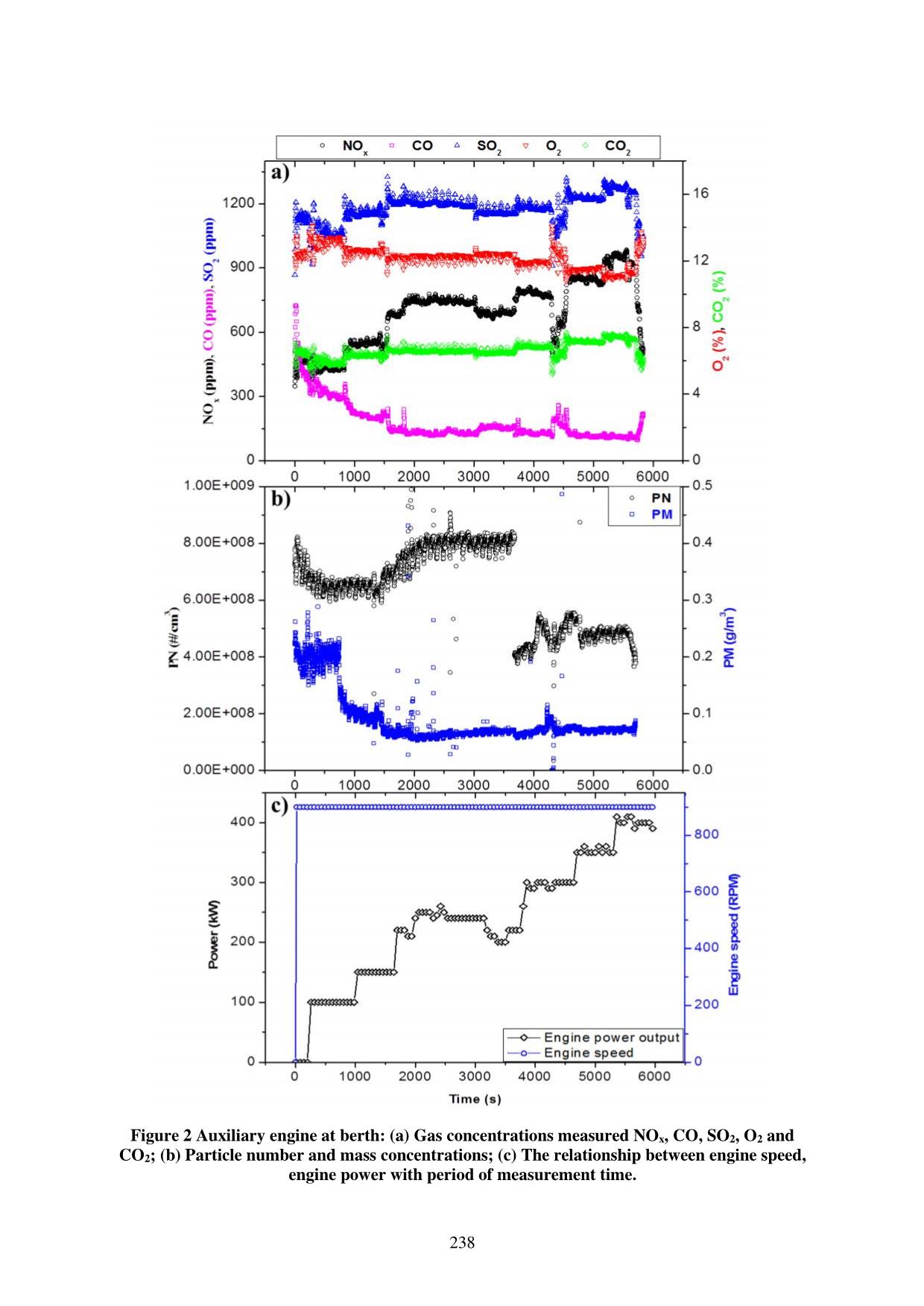
Trang 4
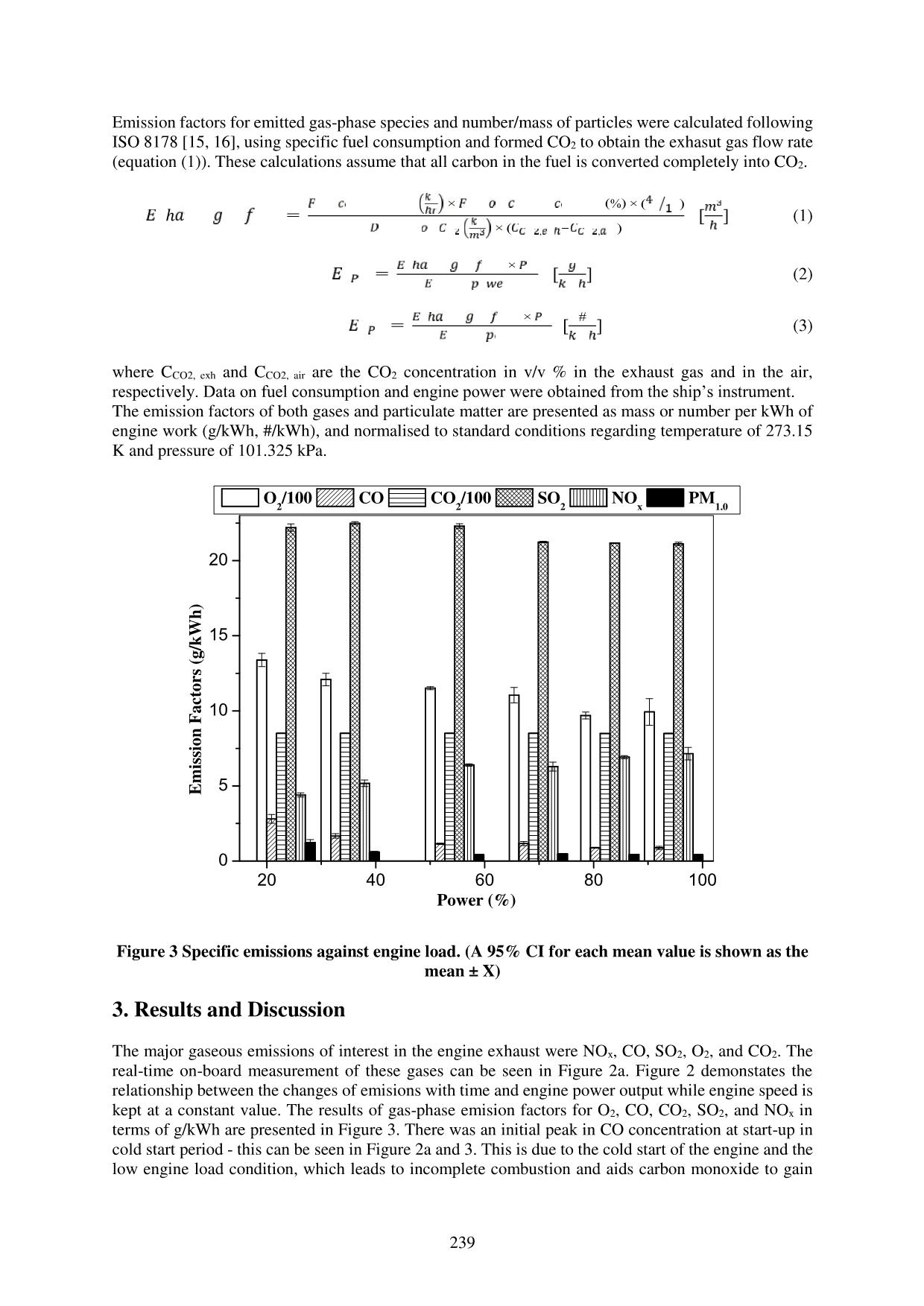
Trang 5
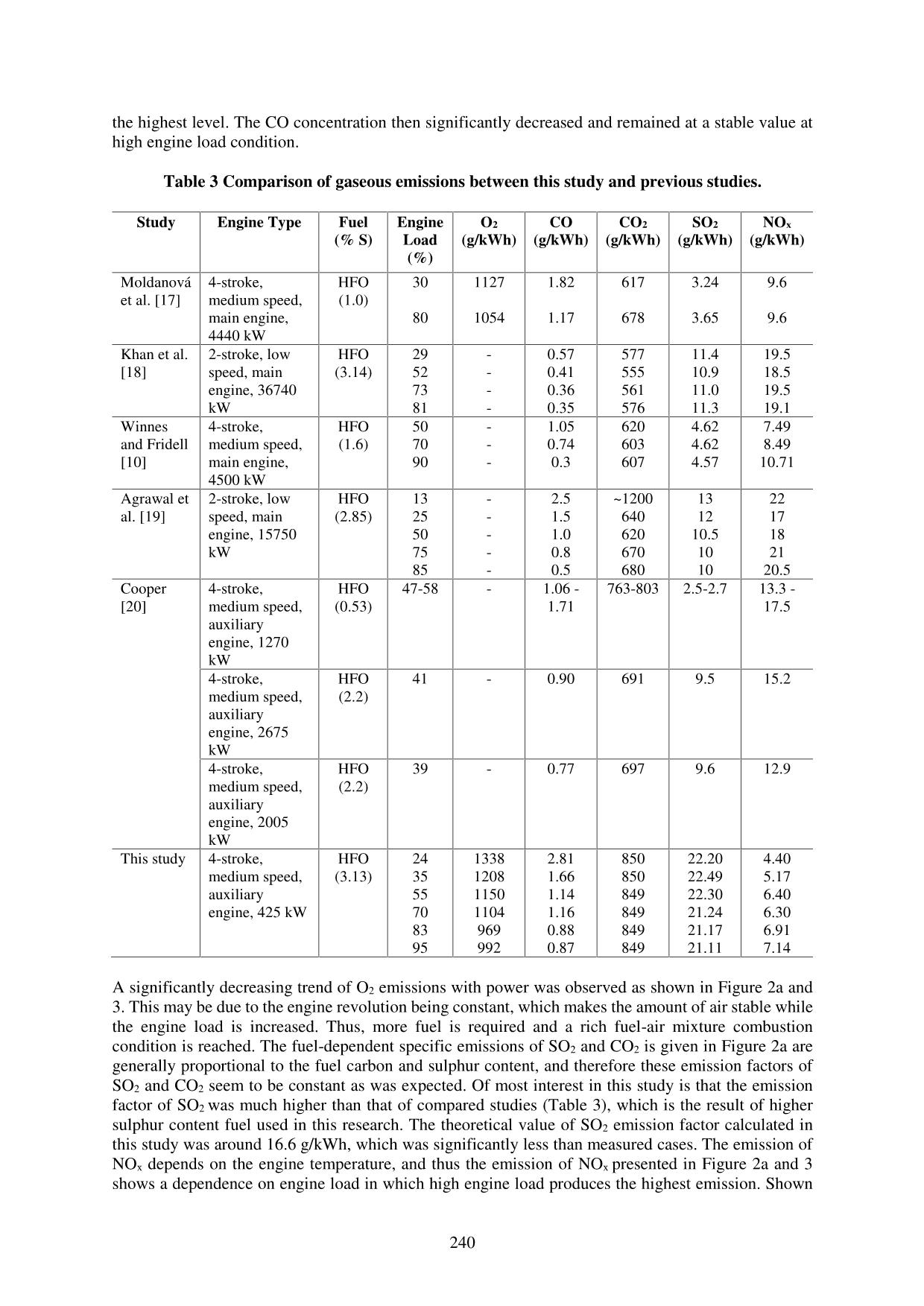
Trang 6
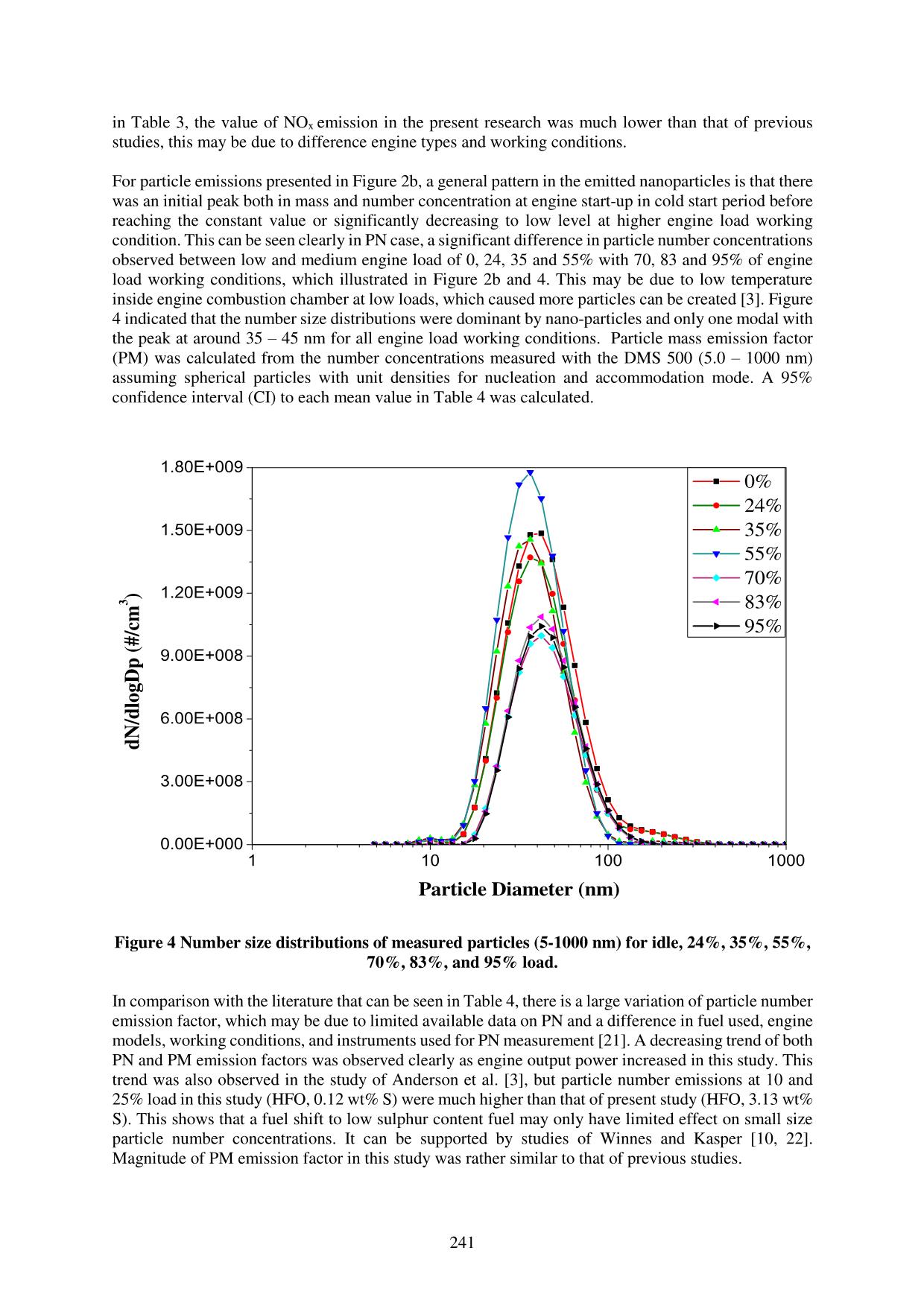
Trang 7
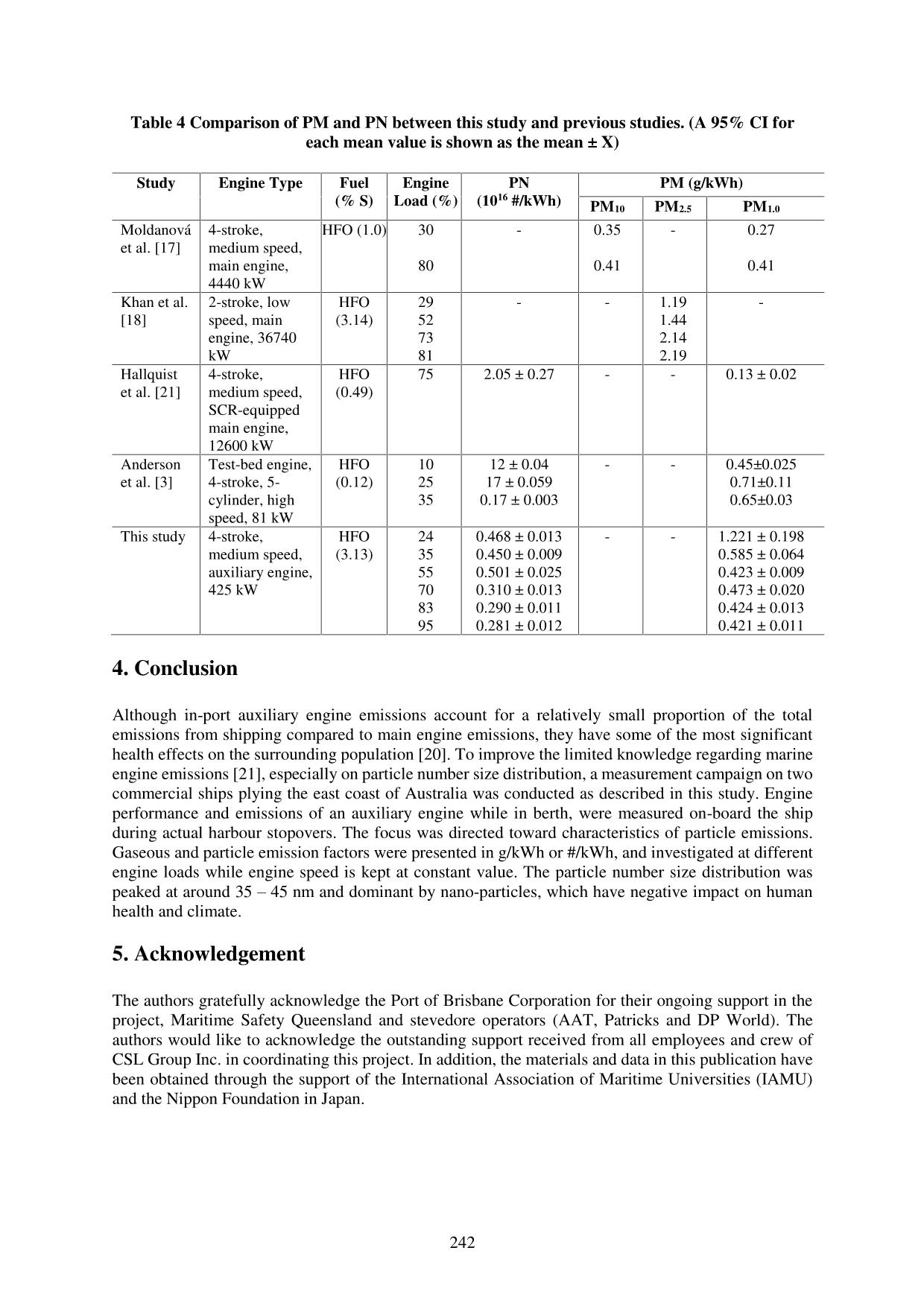
Trang 8

Trang 9
Tóm tắt nội dung tài liệu: Particle emissions from ships at berth using heavy fuel oil
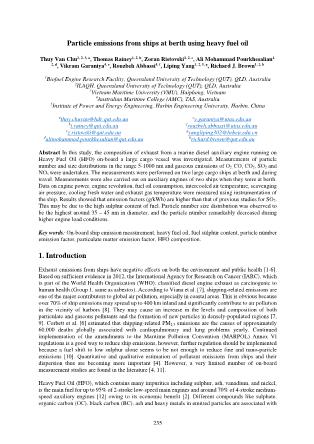
235 Particle emissions from ships at berth using heavy fuel oil Thuy Van Chu1, 2, 3, a, Thomas Rainey1, 2, b, Zoran Ristovski1, 2, c, Ali Mohammad Pourkhesalian1, 2, d , Vikram Garaniya4, e, Rouzbeh Abbassi4, f, Liping Yang1, 2, 5, g, Richard J. Brown1, 2, h 1Biofuel Engine Research Facility, Queensland University of Technology (QUT), QLD, Australia 2ILAQH, Queensland University of Technology (QUT), QLD, Australia 3Vietnam Maritime University (VMU), Haiphong, Vietnam 4Australian Maritime College (AMC), TAS, Australia 5Institute of Power and Energy Engineering, Harbin Engineering University, Harbin, China athuy.chuvan@hdr.qut.edu.au bt.rainey@qut.edu.au cz.ristovski@qut.edu.au dalimohammad.pourkhesalian@qut.edu.au ev.garaniya@utas.edu.au frouzbeh.abbassi@utas.edu.au gyangliping302@hrbeu.edu.cn hrichard.brown@qut.edu.au Abstract In this study, the composition of exhaust from a marine diesel auxiliary engine running on Heavy Fuel Oil (HFO) on-board a large cargo vessel was investigated. Measurements of particle number and size distributions in the range 5-1000 nm and gaseous emissions of O2, CO, CO2, SO2 and NOx were undertaken. The measurements were performed on two large cargo ships at berth and during travel. Measurements were also carried out on auxiliary engines of two ships when they were at berth. Data on engine power, engine revolution, fuel oil consumption, intercooled air temperature, scavenging air pressure, cooling fresh water and exhaust gas temperature were measured using instrumentation of the ship. Results showed that emission factors (g/kWh) are higher than that of previous studies for SO2. This may be due to the high sulphur content of fuel. Particle number size distribution was observed to be the highest around 35 – 45 nm in diameter, and the particle number remarkably decreased during higher engine load conditions. Key words: On-board ship emission measurement, heavy fuel oil, fuel sulphur content, particle number emission factor, particulate matter emission factor, HFO composition. 1. Introduction Exhaust emissions from ships have negative effects on both the environment and public health [1-6]. Based on sufficient evidence in 2012, the International Agency for Research on Cancer (IARC), which is part of the World Health Organization (WHO), classified diesel engine exhaust as carcinogenic to human health (Group 1, same as asbestos). According to Viana et al. [7], shipping-related emissions are one of the major contributors to global air pollution, especially in coastal areas. This is obvious because over 70% of ship emissions may spread up to 400 km inland and significantly contribute to air pollution in the vicinity of harbors [8]. They may cause an increase in the levels and composition of both particulate and gaseous pollutants and the formation of new particles in densely-populated regions [7, 9]. Corbett et al. [6] estimated that shipping-related PM2.5 emissions are the causes of approximately 60,000 deaths globally associated with cardiopulmonary and lung problems yearly. Continued implementation of the amendments to the Maritime Pollution Convention (MARPOL) Annex VI regulations is a good way to reduce ship emissions, however, further regulation should be implemented because a fuel shift to low sulphur alone seems to be not enough to reduce fine and nano-particle emissions [10]. Quantitative and qualitative estimation of pollutant emissions from ships and their dispersion thus are becoming more important [4]. However, a very limited number of on-board measurement studies are found in the literature [4, 11]. Heavy Fuel Oil (HFO), which contains many impurities including sulphur, ash, vanadium, and nickel, is the main fuel for up to 95% of 2-stroke low-speed main engines and around 70% of 4-stroke medium- speed auxiliary engines [12] owing to its economic benefit [2]. Different compounds like sulphate, organic carbon (OC), black carbon (BC), ash and heavy metals in emitted particles are associated with 236 HFO combustion [13, 14]. In practice, while gaseous emissions have been extensively studied over several decades, diesel engine fine and nano-particles have recently emerged as a major health concern and received more attention from researchers and port managers. The aim of this study is to investigate the particle emissions with respect to number concentration and size distribution, from an auxiliary marine engine using HFO (3.13 wt% S) when the ship is at berth. The auxiliary engine operates at a constant speed, with different engine load conditions. 2. Ship Emission On-board Measurement Campaign The measurements were performed in October and November 2015 on two large cargo ships of CSL shipping company at Ports of Brisbane, Gladstone, and Sydney. The work was a collaboration of the Australian Maritime College (AMC), Queensland University of Technology (QUT), and Maine Maritime Academy (MMA). The first on-board measurement was performed on Vessel I from 26th to 31st of October, 2015 when she was running from Port of Brisbane to Port of Gladstone. The second measurement was conducted on Vessel II from 03th to 06th of November, 2015 in her voyage from Gladstone to Newcastle. All measurements have been carried out on both main and auxiliary engines of two ships for different operating ship conditions, such as at berth, manoeuvring, and at sea. The on-board measurement presented in this paper was performed on the auxiliary engine of Vessel II. Instruments were arranged on a deck high up in the machinery room and the exhaust gas was sampled, and measured continuously from a hole cut in the exhaust pipe after turbocharger of auxiliary engine No.1. The details of the measured engine can be seen in Table 1. At the sample point, one hole was created for the present measurements using a Testo 350XL and a DMS 500. The Testo 350XL was calibrated on 10th, August 2015 by the Techrentals Company and was ... 501 0 Carbon residue % mass ISO 10370 14.65 Nickel mg/kg IP 501 34 Total sediment % mass ISO 10307 0.03 Calcium mg/kg IP 501 10 Calorific value MJ/kg IP 501 40.22 Zinc mg/kg IP 501 1 Asphaltenes % mass IP 143 7.42 Potassium mg/kg ASTM D5185 0.8 238 Figure 2 Auxiliary engine at berth: (a) Gas concentrations measured NOx, CO, SO2, O2 and CO2; (b) Particle number and mass concentrations; (c) The relationship between engine speed, engine power with period of measurement time. 239 Emission factors for emitted gas-phase species and number/mass of particles were calculated following ISO 8178 [15, 16], using specific fuel consumption and formed CO2 to obtain the exhasut gas flow rate (equation (1)). These calculations assume that all carbon in the fuel is converted completely into CO2.ℎ = × (%) × ( )× ( , , ) [ ] (1)= × [ ] (2) = × [ # ] (3) where CCO2, exh and CCO2, air are the CO2 concentration in v/v % in the exhaust gas and in the air, respectively. Data on fuel consumption and engine power were obtained from the ship’s instrument. The emission factors of both gases and particulate matter are presented as mass or number per kWh of engine work (g/kWh, #/kWh), and normalised to standard conditions regarding temperature of 273.15 K and pressure of 101.325 kPa. 20 40 60 80 100 0 5 10 15 20 Em iss io n F a ct o rs (g /k W h) Power (%) O2/100 CO CO2/100 SO2 NOx PM1.0 Figure 3 Specific emissions against engine load. (A 95% CI for each mean value is shown as the mean ± X) 3. Results and Discussion The major gaseous emissions of interest in the engine exhaust were NOx, CO, SO2, O2, and CO2. The real-time on-board measurement of these gases can be seen in Figure 2a. Figure 2 demonstates the relationship between the changes of emisions with time and engine power output while engine speed is kept at a constant value. The results of gas-phase emision factors for O2, CO, CO2, SO2, and NOx in terms of g/kWh are presented in Figure 3. There was an initial peak in CO concentration at start-up in cold start period - this can be seen in Figure 2a and 3. This is due to the cold start of the engine and the low engine load condition, which leads to incomplete combustion and aids carbon monoxide to gain 240 the highest level. The CO concentration then significantly decreased and remained at a stable value at high engine load condition. Table 3 Comparison of gaseous emissions between this study and previous studies. Study Engine Type Fuel (% S) Engine Load (%) O2 (g/kWh) CO (g/kWh) CO2 (g/kWh) SO2 (g/kWh) NOx (g/kWh) Moldanová et al. [17] 4-stroke, medium speed, main engine, 4440 kW HFO (1.0) 30 80 1127 1054 1.82 1.17 617 678 3.24 3.65 9.6 9.6 Khan et al. [18] 2-stroke, low speed, main engine, 36740 kW HFO (3.14) 29 52 73 81 - - - - 0.57 0.41 0.36 0.35 577 555 561 576 11.4 10.9 11.0 11.3 19.5 18.5 19.5 19.1 Winnes and Fridell [10] 4-stroke, medium speed, main engine, 4500 kW HFO (1.6) 50 70 90 - - - 1.05 0.74 0.3 620 603 607 4.62 4.62 4.57 7.49 8.49 10.71 Agrawal et al. [19] 2-stroke, low speed, main engine, 15750 kW HFO (2.85) 13 25 50 75 85 - - - - - 2.5 1.5 1.0 0.8 0.5 ~1200 640 620 670 680 13 12 10.5 10 10 22 17 18 21 20.5 Cooper [20] 4-stroke, medium speed, auxiliary engine, 1270 kW HFO (0.53) 47-58 - 1.06 - 1.71 763-803 2.5-2.7 13.3 - 17.5 4-stroke, medium speed, auxiliary engine, 2675 kW HFO (2.2) 41 - 0.90 691 9.5 15.2 4-stroke, medium speed, auxiliary engine, 2005 kW HFO (2.2) 39 - 0.77 697 9.6 12.9 This study 4-stroke, medium speed, auxiliary engine, 425 kW HFO (3.13) 24 35 55 70 83 95 1338 1208 1150 1104 969 992 2.81 1.66 1.14 1.16 0.88 0.87 850 850 849 849 849 849 22.20 22.49 22.30 21.24 21.17 21.11 4.40 5.17 6.40 6.30 6.91 7.14 A significantly decreasing trend of O2 emissions with power was observed as shown in Figure 2a and 3. This may be due to the engine revolution being constant, which makes the amount of air stable while the engine load is increased. Thus, more fuel is required and a rich fuel-air mixture combustion condition is reached. The fuel-dependent specific emissions of SO2 and CO2 is given in Figure 2a are generally proportional to the fuel carbon and sulphur content, and therefore these emission factors of SO2 and CO2 seem to be constant as was expected. Of most interest in this study is that the emission factor of SO2 was much higher than that of compared studies (Table 3), which is the result of higher sulphur content fuel used in this research. The theoretical value of SO2 emission factor calculated in this study was around 16.6 g/kWh, which was significantly less than measured cases. The emission of NOx depends on the engine temperature, and thus the emission of NOx presented in Figure 2a and 3 shows a dependence on engine load in which high engine load produces the highest emission. Shown 241 in Table 3, the value of NOx emission in the present research was much lower than that of previous studies, this may be due to difference engine types and working conditions. For particle emissions presented in Figure 2b, a general pattern in the emitted nanoparticles is that there was an initial peak both in mass and number concentration at engine start-up in cold start period before reaching the constant value or significantly decreasing to low level at higher engine load working condition. This can be seen clearly in PN case, a significant difference in particle number concentrations observed between low and medium engine load of 0, 24, 35 and 55% with 70, 83 and 95% of engine load working conditions, which illustrated in Figure 2b and 4. This may be due to low temperature inside engine combustion chamber at low loads, which caused more particles can be created [3]. Figure 4 indicated that the number size distributions were dominant by nano-particles and only one modal with the peak at around 35 – 45 nm for all engine load working conditions. Particle mass emission factor (PM) was calculated from the number concentrations measured with the DMS 500 (5.0 – 1000 nm) assuming spherical particles with unit densities for nucleation and accommodation mode. A 95% confidence interval (CI) to each mean value in Table 4 was calculated. 1 10 100 1000 0.00E+000 3.00E+008 6.00E+008 9.00E+008 1.20E+009 1.50E+009 1.80E+009 dN /d lo gD p (#/ cm 3 ) Particle Diameter (nm) 0% 24% 35% 55% 70% 83% 95% Figure 4 Number size distributions of measured particles (5-1000 nm) for idle, 24%, 35%, 55%, 70%, 83%, and 95% load. In comparison with the literature that can be seen in Table 4, there is a large variation of particle number emission factor, which may be due to limited available data on PN and a difference in fuel used, engine models, working conditions, and instruments used for PN measurement [21]. A decreasing trend of both PN and PM emission factors was observed clearly as engine output power increased in this study. This trend was also observed in the study of Anderson et al. [3], but particle number emissions at 10 and 25% load in this study (HFO, 0.12 wt% S) were much higher than that of present study (HFO, 3.13 wt% S). This shows that a fuel shift to low sulphur content fuel may only have limited effect on small size particle number concentrations. It can be supported by studies of Winnes and Kasper [10, 22]. Magnitude of PM emission factor in this study was rather similar to that of previous studies. 242 Table 4 Comparison of PM and PN between this study and previous studies. (A 95% CI for each mean value is shown as the mean ± X) Study Engine Type Fuel (% S) Engine Load (%) PN (1016 #/kWh) PM (g/kWh) PM10 PM2.5 PM1.0 Moldanová et al. [17] 4-stroke, medium speed, main engine, 4440 kW HFO (1.0) 30 80 - 0.35 0.41 - 0.27 0.41 Khan et al. [18] 2-stroke, low speed, main engine, 36740 kW HFO (3.14) 29 52 73 81 - - 1.19 1.44 2.14 2.19 - Hallquist et al. [21] 4-stroke, medium speed, SCR-equipped main engine, 12600 kW HFO (0.49) 75 2.05 ± 0.27 - - 0.13 ± 0.02 Anderson et al. [3] Test-bed engine, 4-stroke, 5- cylinder, high speed, 81 kW HFO (0.12) 10 25 35 12 ± 0.04 17 ± 0.059 0.17 ± 0.003 - - 0.45±0.025 0.71±0.11 0.65±0.03 This study 4-stroke, medium speed, auxiliary engine, 425 kW HFO (3.13) 24 35 55 70 83 95 0.468 ± 0.013 0.450 ± 0.009 0.501 ± 0.025 0.310 ± 0.013 0.290 ± 0.011 0.281 ± 0.012 - - 1.221 ± 0.198 0.585 ± 0.064 0.423 ± 0.009 0.473 ± 0.020 0.424 ± 0.013 0.421 ± 0.011 4. Conclusion Although in-port auxiliary engine emissions account for a relatively small proportion of the total emissions from shipping compared to main engine emissions, they have some of the most significant health effects on the surrounding population [20]. To improve the limited knowledge regarding marine engine emissions [21], especially on particle number size distribution, a measurement campaign on two commercial ships plying the east coast of Australia was conducted as described in this study. Engine performance and emissions of an auxiliary engine while in berth, were measured on-board the ship during actual harbour stopovers. The focus was directed toward characteristics of particle emissions. Gaseous and particle emission factors were presented in g/kWh or #/kWh, and investigated at different engine loads while engine speed is kept at constant value. The particle number size distribution was peaked at around 35 – 45 nm and dominant by nano-particles, which have negative impact on human health and climate. 5. Acknowledgement The authors gratefully acknowledge the Port of Brisbane Corporation for their ongoing support in the project, Maritime Safety Queensland and stevedore operators (AAT, Patricks and DP World). The authors would like to acknowledge the outstanding support received from all employees and crew of CSL Group Inc. in coordinating this project. In addition, the materials and data in this publication have been obtained through the support of the International Association of Maritime Universities (IAMU) and the Nippon Foundation in Japan. 243 References [1] Reda, A.A., et al., "Gas phase carbonyl compounds in ship emissions: Differences between diesel fuel and heavy fuel oil operation", Atmospheric Environment, 112, (2015), p. 370-380. [2] Mueller, L., et al., "Characteristics and temporal evolution of particulate emissions from a ship diesel engine", Applied Energy, 155, (2015), p. 204-217. [3] Anderson, M., et al., "Characterization of particles from a marine engine operating at low loads", Atmospheric Environment, 101, (2015), p. 65-71. [4] Blasco, J., et al., "Towards an integrated environmental risk assessment of emissions from ships' propulsion systems", Environment International, 66, (2014),p. 44-7. [5] Ristovski, Z.D., et al., "Respiratory health effects of diesel particulate matter", Respirology, 17, 2, (2012), p. 201-212. [6] Corbett, J.J., et al., "Mortality from Ship Emissions: A Global Assessment", Environmental Scinece & Technology, 41, 24, (2007), p. 8512–8518. [7] Viana, M., et al., "Impact of maritime transport emissions on coastal air quality in Europe", Atmospheric Environment, 90, (2014), p. 96-105. [8] Eyring, V., et al., "Transport impacts on atmosphere and climate: Shipping", Atmospheric Environment, 44, 37, (2010), p. 4735-4771. [9] González, Y., et al., "Ultrafine particles pollution in urban coastal air due to ship emissions", Atmospheric Environment, 45, 28, (2011), p. 4907-4914. [10] Winnes, H. and E. Fridell, "Particle Emissions from Ships: Dependence on Fuel Type", Journal of the Air & Waste Management Association, 59, 12, (2012), p. 1391-1398. [11] Agrawal, H., et al., "In-use gaseous and particulate matter emissions from a modern ocean going container vessel", Atmospheric Environment, 42, 21, (2008), p. 5504-5510. [12] Corbett, J.J., "Updated emissions from ocean shipping", Journal of Geophysical Research, 108, D20, (2003). [13] Anderson, M., et al., "Characterization of particles from a marine engine operating at low loads", Atmospheric Environment, 101, (2015), p. 65-71. [14] Moldanová, J., et al., "Characterisation of particulate matter and gaseous emissions from a large ship diesel engine", Atmospheric Environment, 43, 16, (2009), p. 2632-2641. [15] ISO 8178-2:2008, "Reciprocating internal combustion engines - Exhaust emission measurement - Part 2: Measurement of gaseous and particulate exhaust emissions under field conditions", the International Organization for standard, . [16] ISO 8178-1:2006, "Reciprocating internal combustion engines - Exhaust emission measurement - Part 1: Test-bed measurement of gaseous and particulate exhaust emissions", the International Organization for standard, . [17] Moldanová, J., et al., "Physical and chemical characterisation of PM emissions from two ships operating in European emission control areas", Atmospheric Measurement Techniques, 6, 12, (2013), p. 3577-3596. [18] Khan, M.Y., et al., "Measuring in-use ship emissions with international and U.S. federal methods", Journal of the Air and Waste Management Association, 63, 3, (2013), p. 284-291. [19] Agrawal, H., et al., "Emission measurements from a crude oil tanker at sea", Environmental Science and Technology, 42, 19, (2008), p. 7098-7103. [20] Cooper, D.A., "Exhaust emissions from ships at berth", Atmospheric Environment, 37, 27, (2003), p. 3817-3830. [21] Hallquist, Å.M., et al., "Onboard Measurements of Nanoparticles from a SCR-Equipped Marine Diesel Engine", Enironmental Science & Technology, 47, 2, (2013), p. 773-780. [22] Kasper, A., et al., "Particulate Emissions from a Low-Speed Marine Diesel Engine", Aerosol Science and Technology, 41, 1, (2007), p. 24-32.
File đính kèm:
 particle_emissions_from_ships_at_berth_using_heavy_fuel_oil.pdf
particle_emissions_from_ships_at_berth_using_heavy_fuel_oil.pdf

